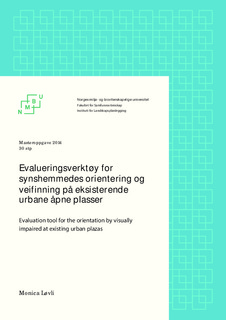Evalueringsverktøy for synshemmedes orientering og veifinning på eksisterende urbane åpne plasser
Abstract
Blant strategiene som Regjeringen presenterer i sin handlingsplan for
et universelt utformet Norge innen 2025, er en utvikling av metoder
og systemer for å måle dagens tilstand og utviklingen med universell
utforming. Synshemmede er en av hensynsgruppene som får lite
oppmerksomhet i planleggingen. Mentaliteten om at «så lenge det
er kunstige ledelinjer har vi dekket behovene til synshemmede» er
ikke et egnet utgangspunkt for å skape optimale uterom med tanke
på orientering og veifi nning. En av de større utfordringene for en
synshemmet er kryssing av store åpne plasser.
Denne oppgaven ønsker å undersøke om planleggingsverktøy
som brukes ved opparbeiding av nye anlegg også kan brukes som
evalueringsverktøy av eksisterende anlegg. Norsk Standard «Universell
utforming av opparbeidete uterom» og veilederen «Arkitektoniske
virkemidler for orientering og veifi nning», utarbeidet av Statens
Vegvesen og Direktoratet for byggkvalitet, blir brukt som utgangspunkt
for en sjekkliste. Jeg søker svar på om dette evalueringsverktøyet gir et
realistisk bilde av den universelle utformingen av en plass, med tanke
på orientering og veifi nning for synshemmede.
Et litteraturstudie ble gjennomført for å fi nne informasjon om
føringer fra lovverk og hvordan synshemmede orienterer seg. Et
evalueringsverktøy i form av en sjekkliste ble utformet ut i fra
krav og anbefalinger fra standarden og veilederen, og ble benyttet i
evalueringen av to eksempelområder i Drammen.
Ut i fra erfaringene fra evalueringene og litteraturstudiet kom det
frem at evalueringsverktøyet fungerer best med utgangspunkt i
både standarden og veilederen. Et evalueringsverktøy, som skal
kunne brukes av planleggere med ulik kunnskap og erfaring innen
universell utforming, bør være tydelig og overlate lite til brukeren av
verktøyet å vurdere. Resultatene skal kunne brukes til å identifi sere
viktige punkter for videre planlegging. For å oppnå en oversikt over
alle hensynsgruppene bør representanter fra de ulike gruppene bidra
i utformingen av evalueringsverktøyet, slik at en totalvurdering
og «diagnose» av anlegget kan gjøres. Noe av det viktigste for
synshemmedes orientering og veifi nning er tilgangen på informasjon
og sammenhengende ledende elementer, som strekker seg lenger enn
bare innenfor en anleggssone. One of the actions presented by the Norwegian Government, through
the plan of action called “Norge universelt utformet 2025”, is a
development of methods and systems for measuring the current state
and development of universal design. Visually impaired is one of the
groups that receive little attention in planning. The mentality that “as
long as there are artifi cial guide lines, the needs of visually impaired
are covered” is not a suitable basis for creating optimal outdoor space
in terms of orientation. One of the bigger challenges for the visually
impaired is crossing large, open plazas.
This thesis wants to investigate whether planning tools used for
planning new city space also could be used as an evaluation tool of
existing facilities. Two documents; Norwegian Standard “Universal
design of developed outdoor areas” and “Architectural elements for
orientation”, prepared by the Norwegian Public Roads Administration
and the Norwegian Directorate for Construction Quality, are used
to make a checklist. I seek answers to whether this evaluation tool
provides a realistic picture of the universal design of a space, in terms
of orientation for visually impaired.
A search for relevant literature was conducted to fi nd information
about statutory guidelines and how visually impaired people orient
themselves. An evaluation tool, made as a checklist, was designed
based on the requirements and recommendations from the two
documents, and was used in the evaluation of two such areas in the city
of Drammen.
Based on lessons learned from both the case evaluations and the
literature study revealed that the evaluation tool works best when based
on both documents. An evaluation tool, to be be used by planners
with different knowledge and experience on universal design, should
be clear and leave little to the planner to assess. The results should
be used to help identify important topics for further work. To obtain
realistic results for all the consideration groups, the development
of the formulation of the evaluation tool should be done with help
from representatives from the various groups. This way an overall
assessment and “diagnosis” of the area can be made. Among the most
important for the visually impaired is the access to information and
continuous conductive elements, which reach further than just within
the border of a small area.
